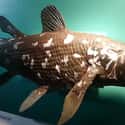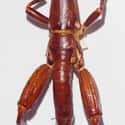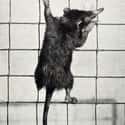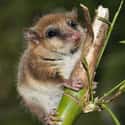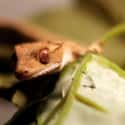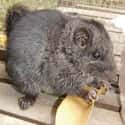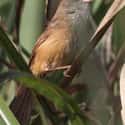-
(#1) Coelacanth
- Coelacanthiformes
The coelacanth is probably the most famous Lazarus species due primarily to the way it was discovered. Paleontologists had found numerous fossils of a large, scaly fish during their excavations, but had always believed the species to be extinct - that is until 1938, when the fish suddenly turned up in a fishing net!
A museum curator by the name of Marjorie Courtenay Latimer received a call one afternoon to come see a strange species of fish and rushed right over. Upon inspection of the five-foot-long animal, Marjorie knew she'd never seen anything like it and decided to consult her colleagues. A year later, it was finally agreed: the fish was in fact a coelacanth! The animal still lives to this day, though it dwells in the depths so it's difficult to find.
-
(#2) Pygmy Tarsier
It makes sense that the world's smallest mammal would also be one of its most vulnerable. They are less than four inches long, weigh next to nothing, and only live in Indonesia. And until recently, they were thought to be extinct. A live one had not been seen in the region since 1930, and scientists decided that it had likely been eradicated. Everyone continued to believe this until one of the little creatures was finally found in a mouse trap in 2000!
Scientists set up nets and were able to catch several live ones, and have since been researching their habitat and numbers. Scientists are still unsure how many of the animals are running about, so they are still considered highly endangered and conservation efforts are in full effect.
-
(#3) Lord Howe Island Stick Insect
The story behind the Lord Howe Island stick insect seems pretty far-fetched, but it is impressively true. Lord Howe Island is a remote and rocky island off the coast of Australia and was once home to a large stick insect referred to as a "tree lobster." Unfortunately, they were apparently also as tasty as real lobster and a ship that ran aground there in 1918 released a pack of rats that loved to snack on them. Within two years, the insects were entirely gone.
Decades passed and a rumor eventually surfaced about a strange insect living on a nearby island called Ball's Pyramid, which is basically just a huge stone spire sticking out of the ocean. In 2001, a pair of Australian scientists decided to climb the spire to see for themselves, and they narrowed their search down to a single plant. There, under that one plant, was a colony of 24 of the insects, alive and kickin'! That one plant is still their only remaining home.
-
(#4) Clarion Nightsnake
The Clarion Nightsnake wasn't a very well-known animal for decades, probably because it had only been spotted once. Then in 1936, renowned naturalist William Beebe visited the island of Clarion and found an oddly spotted snake. He put it in a jar and took it in for study. Return visits failed to find any more of these snakes, and soon the only remaining specimen was considered a labeling error, so the snake was forgotten.
In 1914, a research group was traveling through one of the remote Revillagigedo Islands when a student spotted an oddly patterned snake. After a series of DNA tests, they were able to confirm that this snake was, in fact, the Clarion Nightsnake. Scientists are still uncertain how many of these snakes exist, but they've survived for over 80 years on the little island without being disturbed.
-
(#5) Bermuda Petrel
The cahow, also known as the Bermuda Petrel, is a bird that is rarely seen, even today. When Spanish sailors in the 1500s used Bermuda's islands as stopping points between their attacks on the Incas, they often relied on ever-plentiful Petrel for food. Later, with colonization and the destruction of their natural habitat, the birds soon died out and were declared to be extinct by the early 1600s.
The story could have just stopped there, but a whopping 300 years later zoologist William Beebe was given an injured seabird, which he identified as being a Bermuda Petrel. A few years later, he took in another bird of the same kind before releasing it for rehabilitation. Nowadays, David Wingate watches over the still small colony of birds where they nest on Castle Harbor.
-
(#6) Cuban Solenodon
- Solenodon cubanus
The Cuban solenodon has been around since the era of the dinosaurs - it even still looks a little prehistoric. They're only about 30 centimeters long, have long noses, and are actually venomous - but they're only found in a small part of Cuba. When their habitat was destroyed during the mid 1900s, and when dogs and cats began to eat them en mass, the species quickly found themselves on the decline. And by the 1970s, they were believed to be completely extinct.
Since then, sightings were mentioned here and there, but none were taken very seriously until 2003, when a research team actually captured one and identified it as a solenodon! Only a handful of them have been found, so they're still considered highly endangered, but conservation efforts are underway to try to save this little Lazarus species.
-
(#7) Monito del Monte
- Dromiciops gliroides
You may notice that many animals on this list are small mammals - which also happens to make them great prey animals. However, that's not quite the case for the Monito del Monte of Chile and Argentina. Even though the animal was known to once exist, everyone believed that this particular species had died out 40,000 years ago.
Scientists refer to this animal as a living fossil, because while originally considered a rodent, it was actually found to be a marsupial with its lineage dating all the way back to the middle of the Cenozoic Era! Interestingly enough, their population seems to be holding up pretty well, so these little guys may just stick around for millions of years to come.
-
(#8) New Caledonian Crested Gecko
- Rhacodactylus ciliatus
New Caledonia is a small island just off the coast of Australia that's home to several unique species, including one brightly-colored and spiky little Lazarus species. The New Caledonian Crested Gecko was first discovered in 1866, but soon slipped into obscurity and was thought to be extinct. It wasn't until 1994 - over 100 years later - that scientists realized that these little guys were still around!
In the aftermath of a tropical storm, some of the geckos were discovered after being blown out of their natural forested habitat. Since then, scientists have kept their eye on a small breeding population, originating from a few of the adults found in 1994. All of the geckos you find in the wild today are likely related to those select few.
-
(#9) Laotian Rock Rat
This fluffy little rat lives along the Mekong River (which forms the boarder between Thailand, Myanmar, and Laos) and was originally thought to be its own distinct species. Looking like a mixture of a rat and a squirrel, this rodent was researched in greater detail by scientists in 2005 as they were trying to determine exactly what species it was. Imagine their surprise when they discovered that their odd little rat was actually a species from an ancient rat family assumed to be extinct for over 11 million years!
No one knows how common or widespread these creatures are, but we do know that similar species have showed up in food markets as meat. It's possible that people have actually been eating this ancient species for centuries.
-
(#10) Myanmar Jerdon's Babbler
If you've seen one little brown bird, you've seen them all, right? Many people wouldn't be able to pick out the Myanmar Jerdon's Babbler from any other small brown bird, and it might be this very thing that has allowed it to go undetected for 70 years! The last time the bird was sighted was in 1941, in the grasslands around Myitkyina, Myanmar. Before long, bird books were saying that the animal was extinct, and it continued to slip into obscurity.
Then, in 2013, a group of researchers essentially stumbled across a small population of the birds. They went out to the grassland habitat where they had originally been seen, and heard a strange call. They recorded the call, played it back at high volume, and sure enough, these little brown birds, missing for decades, popped by to see what all the noise was about.
-
(#11) Terror Skink
- Phoboscincus bocourti
Besides having a pretty amazing name, the Terror Skink has a long and mysterious past. We don't know much about where they live, their social structure, habitat, or numbers, but we do know that they only live in New Caledonia, off the coast of Australia. The reason we know so little about them is that scientists had only ever seen one of these reptiles before, a single specimen collected in 1870. Without seeing any more of the animals, scientists assumed that they were extinct.
Then, in 2003, researchers on the island found, captured, and filmed one of the skinks, confirming it is still around! They released the animal back into its habitat after recording it, and the species is now listed as critically endangered.
-

(#12) New Guinea Big-Eared Bat
In 2012, a group of Australian researchers went to Papua New Guinea to study how microbats responded to logging in their habitat. They trapped 41 different species of bats, plus one extra that they just couldn't identify, which they brought back as a sample for study. Years later, researchers finally determined that the specimen in question was a New Guinea big-eared bat, a creature that had not been seen in over 120 years!
One specimen had also been caught in the 80s, but it was misidentified. It had been assumed extinct for nearly a century, and even now we're really not sure how many of these bats remain in the wild.
-
(#13) Takahe
We all know that the Dodo bird is long gone, and one if it's close relatives had also been thought to have gone, well, the way of the Dodo. The takahe is a strange, brightly colored bird that was thought to have gone extinct in 1851, when a researcher said that there were likely none left alive. The bird was officially declared extinct in the late 1800s, and most people forgot that it had even existed.
That is, until Geoffery Orbell mounted an expedition to the Murchison Mountains in Fiordland to find the bird in 1948. They located footprints, then photographed and even caught a few of the birds, proving to the world that they had not died out after all. They are highly endangered today and their numbers are dwindling, so we can only hope that they don't perform a second vanishing act.
-
(#14) Guinea Highland Singing Dog
The New Guinea highland wild dog, also called the singing dog, has long existed in cross breeds with domestic dogs and in captivity, but scientists thought it was completely extinct in the wild. That all changed in 2016, when a muddy paw print was found in the deep forests of the New Guinea highlands. An expedition was launched and before long researchers had a photo of one of the dogs in a remote location, far from human civilization. What was more interesting about this find was that the dog photographed appeared to be pregnant, meaning there were bound to be more of them around.
By 2017, a small group of at least 15 of these dogs have been photographed, proving they still do exist in the wild. This species of dog is considered to be the most ancient and primitive canids in existence today.
New Random Displays Display All By Ranking
About This Tool
When comes to extinction, most people will think of dinosaurs, mammoths. In fact, species extinctions never stop happening. Many authoritative studies and scholars have stated that some species are all extinct, but they never expected that these animals would miraculously come back. The coelacanth is a veritable living fossil, this species has long been thought to have become extinct about 60 million years ago, but in 1938, a living species was caught on the coast of southern Africa.
Are you interested in other unique species? The random tool introduced 14 extinct species that were once again found in other areas, they are still endangered animals and remind all humans that it is urgent to protect the habitat and ecological environment.
Our data comes from Ranker, If you want to participate in the ranking of items displayed on this page, please click here.











